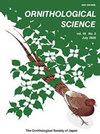Population Genetic Structure of Little Tern (Sternula albifrons) in Japan Inferred from Nucleotide Sequence Diversities of the Mitochondrial DNA Control Region
IF 0.3
4区 生物学
Q4 ORNITHOLOGY
引用次数: 1
Abstract
Abstract Little Tern Sternula albifrons sinensis was been categorized as Endangered Class II by the 2020 Ministry of the Environment's Red List in Japan. For an effective conservation program for the taxon, the unit of conservation needs to be understood. In this study, we investigated genetic and morphological diversity as a clue to clarify the units to be protected. Blood samples were collected from 47 individuals in four different breeding sites in Japan (Tokyo, Chiba, Fukuoka, Okinawa). The nucleotide sequences of the control region of mitochondrial DNA were used to analyze their genetic diversity and structure. Basic morphological features were also compared. Nucleic acid base substitution, deletion, or insertion were identified at 30 sites of the 1029-bp sequence alignment of the control region, leading to identification of 30 different haplotypes. Genetic diversity was high in the four breeding populations, and haplotype frequencies showed no indication that specific genotypes were present at extreme frequencies. This suggests that the population of Little Tern nesting in Japan has been maintained without recent bottleneck events. The haplotype network formed two major haplotype groups from the 30 haplotypes. Haplotypes of one group were abundant in the Tokyo, Chiba, and Fukuoka populations. In contrast, those of the other group were frequent in the Okinawa population. Pairwise haplotype analysis between populations also revealed that the genetic variations at Okinawa differ from those of the remaining three populations. Furthermore, the Okinawa population showed different morphological characteristics compared to the Tokyo/Chiba populations. These results collectively suggest that the population of Little Terns in Japan is divided into at least two different populations.从线粒体DNA控制区核苷酸序列差异推断日本小燕鸥群体遗传结构
摘要:2020年日本环境部《濒危物种红色名录》将白胸小燕鸥列为濒危物种II类。为了制定有效的保护计划,需要了解保护单位。在本研究中,我们调查了遗传和形态多样性,作为明确保护单位的线索。在日本4个不同的繁殖地点(东京、千叶、福冈、冲绳)采集了47只个体的血液样本。利用线粒体DNA控制区核苷酸序列分析其遗传多样性和结构。并比较了基本形态学特征。在对照区1029bp序列比对的30个位点鉴定出核酸碱基置换、缺失或插入,从而鉴定出30种不同的单倍型。4个繁殖群体的遗传多样性较高,单倍型频率在极端频率下不存在特定基因型。这表明在日本筑巢的小燕鸥数量一直保持不变,没有最近的瓶颈事件。单倍型网络从30个单倍型中形成了两个主要的单倍型群。其中一个群体在东京、千叶和福冈种群中具有丰富的单倍型。相比之下,另一组在冲绳人口中很常见。群体间的单倍型分析也揭示了冲绳的遗传变异与其他三个群体的遗传变异不同。此外,冲绳种群与东京/千叶种群表现出不同的形态特征。这些结果共同表明,日本的小燕鸥至少分为两个不同的种群。
本文章由计算机程序翻译,如有差异,请以英文原文为准。
求助全文
约1分钟内获得全文
求助全文
来源期刊

Ornithological Science
ORNITHOLOGY-
CiteScore
1.20
自引率
0.00%
发文量
26
审稿时长
>12 weeks
期刊介绍:
Ornithological Science publishes reviews, original articles, short communications and comments covering all aspects of ornithology. Manuscripts are judged on the basis of their contribution of original data and ideas or interpretation. All articles are peer-reviewed by at least two researchers expert in the field of the submitted paper. Manuscript are edited where necessary for clarify and economy. Ornithological Science aims to publish as rapidly as is consistent with the requirements of peer-review and normal publishing constraints.
 求助内容:
求助内容: 应助结果提醒方式:
应助结果提醒方式:


